Dogs
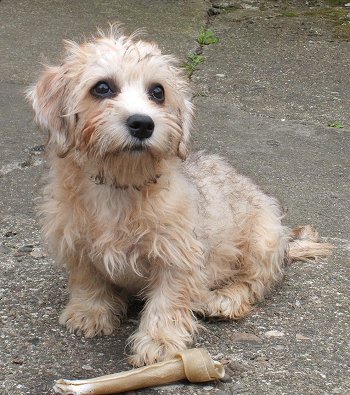

A Dandie Dinmont Terrier is a small breed of dog in the terrier family. The breed has a very long body, short legs, and a distinctive "top-knot" of hair on the head.

Description 1
Appearance
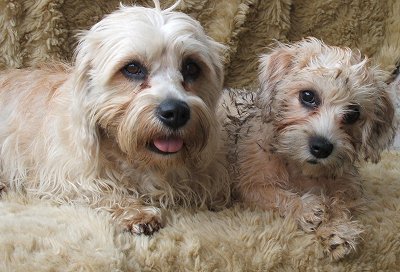
Originally bred to go to ground, the Dandie Dinmont Terrier is a long, low-stationed working terrier with a curved topline. The distinctive head with silken topknot is large but in proportion to the size of the dog. The dark eyes are large and round with a soft, wise expression. Dandie Dinmonts are between 8 and 11 inches tall at the top of the shoulders and can weigh between 18 and 24 pounds. The dogs are sturdily built with strong bone structure and ample muscular strength. The sturdy, flexible body and scimitar shaped tail are covered with a rather crisp double coat, either mustard or pepper in color. Pepper ranges from dark bluish black to a light silvery gray, the topknot is a silvery white. Mustard can range from a reddish brown to a pale fawn, with the topknot a creamy white.
This breed has little to no shedding (see Moult).
Temperament 1
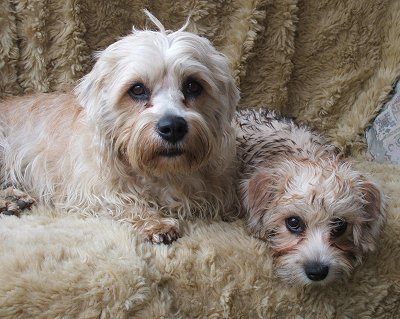
The Dandie Dinmont is affectionate and fun-loving. It makes a great companion dog. Lively, plucky, determined and willful. Independent and intelligent. Bold yet dignified. Reserved with strangers and protective of family and home. Good with all well-behaved children and babies as long as they are raised with them from puppyhood. Dominance level varies greatly. Some males can be aggressive with other male dogs in the household while females can be snappy and bad tempered
History
This short legged terrier was developed in the 17th century as an otter and badger specialist in the Cheviot and Teviotdale Hills in the border country of Scotland and England. The Dandie Dinmont Terrier is named after Dandie Dinmont, a jovial farmer in Sir Walter Scott's novel Guy Mannering. Scott also gave the names to the breed's colours, pepper and mustard, which were adopted from the names of Dandie Dinmont's dogs. The Dandie Dinmont Terrier is the only breed to be named after a character in fiction.
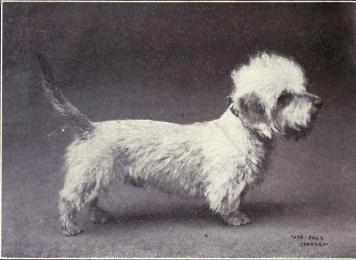
In the 1870s, exhibiting dogs became popular. The Kennel Club formed in 1873 and, just after this time, moves were made by Dandie enthusiasts to form a club. On November 17, 1875, at a meeting held at the Fleece Hotel in Selkirk on the Scottish Borders, the Dandie Dinmont Terrier Club was formed. It is one of the oldest pedigree breed clubs in the world.
The first task was to draw up a breed standard and Mr William Wardlaw Reed, a founder member of the DDTC. worked on this, smoothing out the many differences. The following year at the Red Lion Hotel, Carlisle, the standard was agreed and adopted.
The breed was first registered with the American Kennel Club (AKC) in 1888. The Dandie Dinmont Terrier was recognized by the United Kennel Club (UKC) in 1918.
Today the Dandie Dinmont is amongst the rarest and most endangered of all pure breeds/pedigree dogs. The UK Kennel Club list the Dandie as one of the UK's Vulnerable Native Dog Breeds and there is a very real chance of the breed becoming extinct.
A Dandie Dinmont called Dodo features in Gerald Durrell's book: My Family and Other Animals Chapter 16.
Description 2
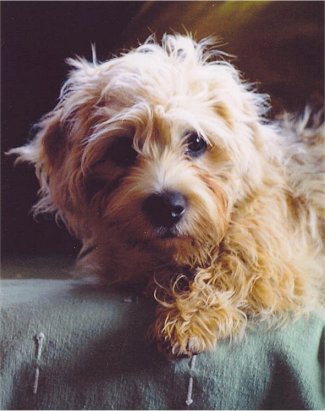
The Dandie Dinmont Terrier is a low to the ground, longer than he is tall, little dog. The large head has a topknot that is in proportion to the body. The skull is broad between the ears, gradually tapering to the eyes. The muzzle is deep, with a well defined stop. The large teeth meet in a scissors bite. The moderately, large nose and the lips are dark in color. The large, round, wide-set eyes come in dark hazel with dark eye rims. The 3 to 4 inch (7-10 cm.) ears are pendant, set low and wide, hanging close to the cheeks. The legs are short with the back legs being a little longer than the front legs. The "scimitar" tail looks like a curved sword and is about 8 to 10 inches (20-25 cm.) long, thicker for about 4 inches then tapering to a point. Dewclaws may be removed when puppies are three or four days old.. The coat is about 2 inches (5 cm.) long with with a mix of soft and hard hairs. Hair on the underside is softer in texture and the head is covered with an even softer, silky topknot. Coat colors come in pepper (dark bluish black to a light silvery gray) or mustard (reddish brown to a pale fawn). Mustard puppies are born with a dark brown coat which lightens into varying shades of red when it reaches an adult. Pepper puppies are born black and tan, that silvers later in life. Pepper coats have a silver topknot and mustard color coats have a cream colored topknot.
Temperament 2
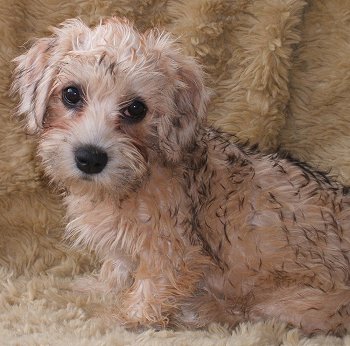
The Dandie Dinmont makes a great companion dog, affectionate and happy-go-lucky. Lively, bold, brave, independent and intelligent. Because of this terrier's hunting instincts, it should not be trusted with non-canine pets, such as hamsters, rabbits, pet mice and guinea pigs. It will be okay with cats that it is raised with from puppyhood. They are not difficult to train, if you are firm and consistent. Makes a good watch dog, but needs to be told, after getting your attention with the first warning bark, it is time to be quiet and let you handle the rest. Because of this breeds small size, a lot of Dandie Dinmont Terriers develop Small Dog Syndrome, human induced behaviors, where the dog believes he is king of the home. Led to believe they own the humans and everything else around them, and do their best to keep and defend what they own. This causes many varying degrees of behavior issues, including, but not limited to stubbornness, determined, willful, guarding, separation anxiety, hard to obedience train, reserve with strangers, snapping, biting, dog-aggressiveness, and obsessive barking, as the dog tries to keep his humans and everyone else around him in line. These are NOT Dandie Dinmont traits, but behaviors brought on by the lack of a firm consistent pack leader, who provides, rules, and limits to what they are and are not allowed to do, along with the lack of a daily pack walk. As soon as the humans take the control away from the dog, and the dog's instincts are met, the negative behaviors will begin to subside and the Dandie Dinmont will be a wonderful, trustworthy, family companion.
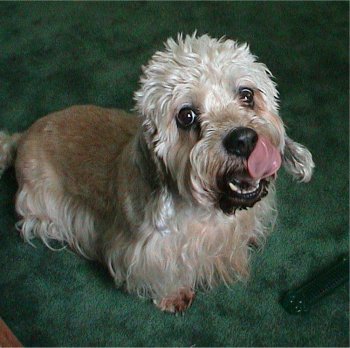
Height, Weight
Height: 8-11 inches (20-28 cm.)
Weight: 18-24 pounds (8-11 kg.)
Health Problems
Generally a healthy breed. Some are prone to glaucoma and epilepsy. Hypothyroidism can occur when the dog is older. Do not overfeed as an overweight dog can have back problems.
Living Conditions
The Dandie Dinmont Terrier is good for apartment life. They are fairly active indoors and a small yard will do as long as you take them for daily walks. Likes to chase, be careful when taking them off the leash.
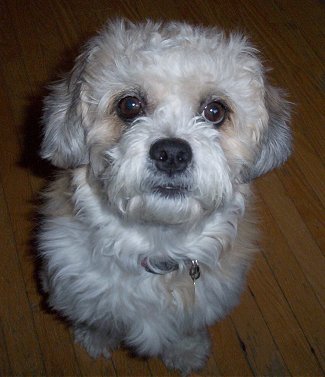
Exercise
Dandie Dinmont need to be walked daily. They will also enjoy sessions of play in the park or other safe open areas.
Life Expectancy
About 12-15 years.
Grooming
The Dandie Dinmont needs to be brushed regularly. They should have professional grooming. Dead hair should be plucked out once or twice a year. Show dogs require much more grooming. This breed sheds little to no hair.
Origin

The Dandie Dinmont is an old terrier dating back to the 1700s originating from the border area between England and Scotland. The breed may have been developed from the Skye Terrier and the now extinct Scotch Terrier (not to be confused with today's Scottish Terrier). The breed was popular among the gypsies and was used by farmers to kill vermin. With its short legs it was able to go to ground hunting badgers and otter. In 1814 Sir Walter Scott wrote about the breed in is famous novel "Guy Mannering". In the book there was a character named Dandie Dinmont, and that is where the breed got it's name. It was recognized by the AKC in 1886. Some of the Dandie Dinmont's talents are vermin catcher, hunting rabbit, otter, badger, martens, weasels, and skunks.
- Yorkshire Terrier (yorkie)
The Yorkshire Terrier or Yorkie is well know due to its small size. This breed has love and loyalty for their master and family member but can be aggressive with stranger and also with small dogs. This dog breed, as a lap...
- Cesky Terrier Small Breed Dog
The Cesky Terrier is a small terrier type dog originating in Czechoslovakia. The name is pronounced CHESS-kee (after its Czech name Český teriér, literally Czech Terrier). History The Český Terrier was created by a Czech breeder, František...
- Australian Terrier Small Dog Breed
The Australian Terrier is a small sized breed of dog of the terrier dog type. The breed was developed in Australia, although the ancestral types of dogs from which the breed descends were from Great Britain. Appearance The Australian Terrier is a...
- Types Of Dogs With Pictures - Terrier Group
Types of Dogs With Pictures - Terrier Group This type of dogs are commonly used for hunting animals which commonly go underground like rats, badgers and foxes. The terriers would then have to dig them out or locate them so the hunter could dig them...
- Types Of Dogs With Pictures - Terrier Group
Types of Dogs With Pictures - Terrier Group This type of dogs are commonly used for hunting animals which commonly go underground like rats, badgers and foxes. The terriers would then have to dig them out or locate them so the hunter could dig them...
Dogs
Dandie Dinmont Terrier small dog breed

A Dandie Dinmont Terrier is a small breed of dog in the terrier family. The breed has a very long body, short legs, and a distinctive "top-knot" of hair on the head.

Description 1
Appearance
This breed has little to no shedding (see Moult).
Temperament 1
History
This short legged terrier was developed in the 17th century as an otter and badger specialist in the Cheviot and Teviotdale Hills in the border country of Scotland and England. The Dandie Dinmont Terrier is named after Dandie Dinmont, a jovial farmer in Sir Walter Scott's novel Guy Mannering. Scott also gave the names to the breed's colours, pepper and mustard, which were adopted from the names of Dandie Dinmont's dogs. The Dandie Dinmont Terrier is the only breed to be named after a character in fiction.
The first task was to draw up a breed standard and Mr William Wardlaw Reed, a founder member of the DDTC. worked on this, smoothing out the many differences. The following year at the Red Lion Hotel, Carlisle, the standard was agreed and adopted.
The breed was first registered with the American Kennel Club (AKC) in 1888. The Dandie Dinmont Terrier was recognized by the United Kennel Club (UKC) in 1918.
Today the Dandie Dinmont is amongst the rarest and most endangered of all pure breeds/pedigree dogs. The UK Kennel Club list the Dandie as one of the UK's Vulnerable Native Dog Breeds and there is a very real chance of the breed becoming extinct.
A Dandie Dinmont called Dodo features in Gerald Durrell's book: My Family and Other Animals Chapter 16.
Description 2
Temperament 2
Height: 8-11 inches (20-28 cm.)
Weight: 18-24 pounds (8-11 kg.)
Health Problems
Generally a healthy breed. Some are prone to glaucoma and epilepsy. Hypothyroidism can occur when the dog is older. Do not overfeed as an overweight dog can have back problems.
Living Conditions
The Dandie Dinmont Terrier is good for apartment life. They are fairly active indoors and a small yard will do as long as you take them for daily walks. Likes to chase, be careful when taking them off the leash.
Dandie Dinmont need to be walked daily. They will also enjoy sessions of play in the park or other safe open areas.
Life Expectancy
About 12-15 years.
Grooming
The Dandie Dinmont needs to be brushed regularly. They should have professional grooming. Dead hair should be plucked out once or twice a year. Show dogs require much more grooming. This breed sheds little to no hair.
Origin
The Dandie Dinmont is an old terrier dating back to the 1700s originating from the border area between England and Scotland. The breed may have been developed from the Skye Terrier and the now extinct Scotch Terrier (not to be confused with today's Scottish Terrier). The breed was popular among the gypsies and was used by farmers to kill vermin. With its short legs it was able to go to ground hunting badgers and otter. In 1814 Sir Walter Scott wrote about the breed in is famous novel "Guy Mannering". In the book there was a character named Dandie Dinmont, and that is where the breed got it's name. It was recognized by the AKC in 1886. Some of the Dandie Dinmont's talents are vermin catcher, hunting rabbit, otter, badger, martens, weasels, and skunks.
- Yorkshire Terrier (yorkie)
The Yorkshire Terrier or Yorkie is well know due to its small size. This breed has love and loyalty for their master and family member but can be aggressive with stranger and also with small dogs. This dog breed, as a lap...
- Cesky Terrier Small Breed Dog
The Cesky Terrier is a small terrier type dog originating in Czechoslovakia. The name is pronounced CHESS-kee (after its Czech name Český teriér, literally Czech Terrier). History The Český Terrier was created by a Czech breeder, František...
- Australian Terrier Small Dog Breed
The Australian Terrier is a small sized breed of dog of the terrier dog type. The breed was developed in Australia, although the ancestral types of dogs from which the breed descends were from Great Britain. Appearance The Australian Terrier is a...
- Types Of Dogs With Pictures - Terrier Group
Types of Dogs With Pictures - Terrier Group This type of dogs are commonly used for hunting animals which commonly go underground like rats, badgers and foxes. The terriers would then have to dig them out or locate them so the hunter could dig them...
- Types Of Dogs With Pictures - Terrier Group
Types of Dogs With Pictures - Terrier Group This type of dogs are commonly used for hunting animals which commonly go underground like rats, badgers and foxes. The terriers would then have to dig them out or locate them so the hunter could dig them...
